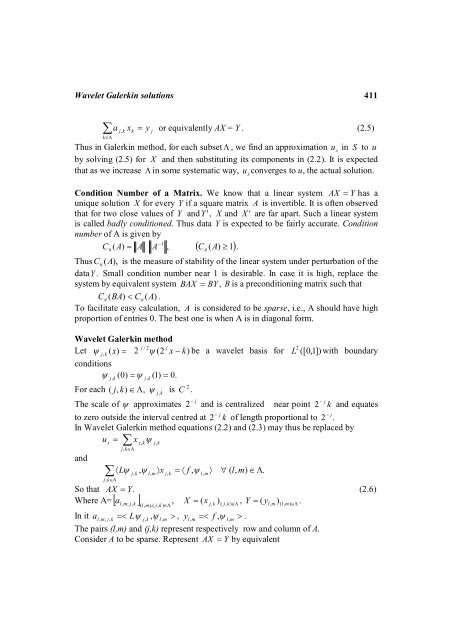Wavelet Galerkin Solutions of Ordinary Differential Equations
Wavelet Galerkin Solutions of Ordinary Differential Equations
Wavelet Galerkin Solutions of Ordinary Differential Equations
Create successful ePaper yourself
Turn your PDF publications into a flip-book with our unique Google optimized e-Paper software.
<strong>Wavelet</strong> <strong>Galerkin</strong> solutions 411<br />
<br />
k<br />
a x y<br />
j,<br />
k k j or equivalently AX = Y . (2.5)<br />
Thus in <strong>Galerkin</strong> method, for each subset , we find an approximation u s in S to u<br />
by solving (2.5) for X and then substituting its components in (2.2). It is expected<br />
that as we increase in some systematic way, us converges to u, the actual solution.<br />
Condition Number <strong>of</strong> a Matrix. We know that a linear system AX Y has a<br />
unique solution X for every Y if a square matrix A is invertible. It is <strong>of</strong>ten observed<br />
that for two close values <strong>of</strong> Y andY ',<br />
X and X ' are far apart. Such a linear system<br />
is called badly conditioned. Thus data Y is expected to be fairly accurate. Condition<br />
number <strong>of</strong> A is given by<br />
1<br />
( A)<br />
A A , C ( A)<br />
1 .<br />
C <br />
#<br />
#<br />
Thus # ( ), A C is the measure <strong>of</strong> stability <strong>of</strong> the linear system under perturbation <strong>of</strong> the<br />
data Y . Small condition number near 1 is desirable. In case it is high, replace the<br />
system by equivalent system BAX BY , B is a preconditioning matrix such that<br />
C# ( BA)<br />
C#<br />
( A)<br />
.<br />
To facilitate easy calculation, A is considered to be sparse, i.e., A should have high<br />
proportion <strong>of</strong> entries 0. The best one is when A is in diagonal form.<br />
<strong>Wavelet</strong> <strong>Galerkin</strong> method<br />
j / 2 j<br />
Let j,<br />
k ( x)<br />
2 ( 2 x k)<br />
be a wavelet basis for<br />
conditions<br />
2<br />
L ([ 0,<br />
1])<br />
with boundary<br />
0)<br />
( 1)<br />
0.<br />
j,<br />
k ( j,<br />
k<br />
For each ( j , k)<br />
,<br />
j,<br />
k is<br />
The scale <strong>of</strong> approximates<br />
2<br />
C .<br />
j<br />
2 and is centralized near point k<br />
j <br />
2 and equates<br />
to zero outside the interval centred at k<br />
j <br />
2 <strong>of</strong> length proportional to 2 .<br />
j <br />
In <strong>Wavelet</strong> <strong>Galerkin</strong> method equations (2.2) and (2.3) may thus be replaced by<br />
x<br />
and<br />
u s<br />
j,<br />
k j,<br />
k<br />
j,<br />
k<br />
<br />
<br />
<br />
j,<br />
k<br />
L<br />
j,<br />
k , l,<br />
m x<br />
j,<br />
k f , l,<br />
m <br />
( l,<br />
m)<br />
.<br />
So that AX Y.<br />
(2.6)<br />
Where A= a , X ( x j,<br />
k ) ( j,<br />
k ) <br />
, Y ( yl<br />
, m ) ( l,<br />
m)<br />
<br />
.<br />
l,<br />
m;<br />
j,<br />
k ( l,<br />
m),<br />
( j,<br />
k ) <br />
In it a l,<br />
m;<br />
j,<br />
k L<br />
j,<br />
k , l,<br />
m , yl , m f , l,<br />
m .<br />
The pairs (l,m) and (j,k) represent respectively row and column <strong>of</strong> A.<br />
Consider A to be sparse. Represent AX Y by equivalent
















